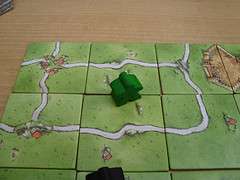Carcassonne

A tile-based board game (and its numerous sequels) in which players compete to control and complete cities, roads and fields. Part of the Euro Game genre.
It takes place in the southern France city of Carcassonne, with each player representing the land developers responsible for the city's famous architecture and layout.
The gameplay has players drawing tiles with roads, cities, fields, and farms on them, and placing them on the table to match other tiles. When a player places a tile, they can put one of their "meeples" (small wooden pieces representing workers) on one of its features. When a given feature is completed (trails having two end points, cities being completely enclosed, etc.), the player with a meeple on it scores points. The game ends when every tile has been placed, and the player with the most points is the winner.
- Art Evolution: Compare the art of the original to the art of New World- the latter is much more vibrant and detailed.
- Artifact Title: Several expansions and sequels don't have much to do with the eponymous city anymore. One reason for the Market-Based Title below may have been to avoid this.
- Expansion Pack: The original game has 20 expansions of varying size and complexity; some just add new tiles, while others add whole new mechanics and pieces.
- Market-Based Title: Carcassonne: Mayflower (it takes place in freshly colonized America) was renamed New World: A Carcassonne Game when it was exported to the states.
- Patchwork Map: Averted—the board is built from randomly-drawn tiles, but the features on each newly placed tile have to match the ones on the previously-played adjacent tiles.
- Nice Hat: every meeple in New World has a top hat.
- Volcano Lair: Whenever a volcano is placed, the dragon flies towards it.